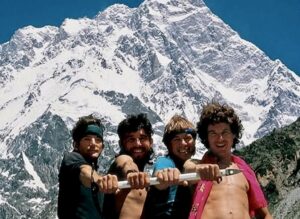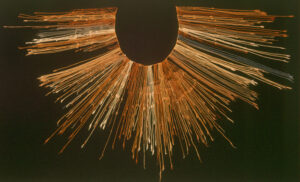With Herve Barmasse and David Goettler poised to attempt 8,167m Dhaulagiri I, it’s a good time to review past winter attempts on the seventh-highest mountain in the world. Our information comes from The Himalayan Database and the American Alpine Journal.
Note that the Dhaulagiri massif has several 7,000’ers and 6,000’ers, apart from its principal peak, Dhaulagiri I. These include Dhaulagiri II (7,751m), Dhaulagiri III (7,715m), Dhaulagiri IV (7,661m), Dhaulagiri V (7,618m), Churen Himal Main (7,385m), two other Churen Himal peaks above 7,000m, and finally two more 7,000m peaks, Putha Hiunchuli and Gurja Himal. Here, we focus on the one 8,000’er, Dhaulagiri I, also known as the White Mountain.
Non-attempts
Before its first ascent in the spring of 1960, six expeditions had unsuccessfully attempted Dhaulagiri I.
A U.S. team claimed to have attempted Dhaulagiri in 1949, but The Himalayan Database did not confirm their expedition and we haven’t counted it.
In 1950, a French party led by Maurice Herzog made a reconnaissance of the Southeast Ridge and the North Face of Dhaulagiri I, but did not try to climb the mountain. Instead, they went to Annapurna I (8,091m). On June 3, 1950, Maurice Herzog and Louis Lachenal climbed Annapurna I. It was the first successful ascent of an 8,000m peak.

Dhaulagiri North Face from the French col. Photo: Trip Advisor
Attempts
The six parties that actually attempted Dhaulagiri I before its first ascent did so between 1953 and 1959. All went in spring.
In 1953, a Swiss team led by Bernhard Lauterburg reached 7,700m on the North Face using supplemental oxygen. Due to the route’s difficulty, they gave up.
In 1954, an Argentinian-Austrian-Chilean party led by Francisco Ibanez could not get higher than 8,000m on the North Face. Ibanez himself fell ill, suffered severe frostbite, and died later in Kathmandu. The party used bottled O2.
One year later, a Swiss-German party led by Martin Meier reached 7,600m on the North Face but gave up because of bad weather and heavy snow.
An Argentinian-Indian party attempted to climb the North Face in 1956. They reached 7,700m. The Himalayan Database suggests that a lack of supplies (including enough O2) and poor organization caused the failure of the expedition.
In 1958, a Polish-German team tried to climb no-O2 but aborted at 7,600m because of deep snow and avalanche danger.
Finally, in 1959, Fritz Moravec’s Austrian team reached 7,800m on the Northeast Ridge without bottled oxygen.

Dhaulagiri I Base Camp. Photo: Herve Barmasse
The first ascent
A multinational team (Swiss, Austrian, Polish, American, and German) under Max Eiselin finally climbed Dhaulagiri I for the first time via its Northeast Ridge in 1960, without oxygen. The first summiters were Kurt Diemberger, Peter Diener, Ernst Forrer, Albin Schelbert, Nawang Dorje Sherpa, and Nima Dorje Sherpa. They topped out on May 13. Ten days later, Michel Vaucher and Hugo Weber also summited.
From that first ascent until spring 2022, a total of 647 people have summited Dhaulagiri I. Of these, 389 went without bottled oxygen.
Eighty-six climbers have perished on this peak. The last death occurred on April 12, 2022, when Antonios Sykaris of Greece succumbed to exhaustion at 7,400m, after summiting.
Among the 86 deaths, four died during the winter of 1989. Those are the only winter fatalities.

The Northeast Ridge of Dhaulagiri I. Photo: Animal de Ruta
Dhaulagiri I winter expeditions
Not counting Herve Barmasse and David Goettler, 13 teams have attempted Dhaulagiri in winter. Given the controversy over meteorological vs astronomical winter, it’s interesting to consider the dates that these previous expeditions arrived at their Base Camp.
Except for Barmasse and Goettler, all 13 other teams reached their base camps before Dec. 21. Eleven teams arrived in November, and another two in the first week of December.
Again excepting Barmasse/Goettler, all the other winter expeditions took place between 1982 and 1995.
Manaslu and Kangchenjunga show a similar trend regarding winter base camp arrivals. Among the 24 winter expeditions to Manaslu, 14 arrived at Base Camp before Dec. 21. This was the trend in the 1980s and 1990s.
Kangchenjunga has had just three winter expeditions (1984-5, 1985-86, and 1987-8). Again, everyone arrived at base camp before Dec. 21 (Nov. 29, Dec. 9, and Dec. 8, respectively).

Dhaulagiri Southeast Ridge and East Face. Photo: Mountains of Travel
Winter ascents
Eleven climbers on five different teams have made it to the top of Dhaulagiri I in winter. The first winter ascent took place on Dec. 13, 1982. Akio Koizumi of the Academic Alpine Club of Hokkaido, Japan and Wangchu Sherpa of Nepal went up the Northeast Ridge (the normal route).
Wangchu used O2 to 8,000m, then dumped it to lighten his load. He thought it would be unnecessary since he had already climbed Manaslu and Makalu without oxygen. He felt dizzy but managed to finish the climb and descend safely. Koizumi used oxygen all the way to the top, where he ran out.
On the way down, the two climbers survived a bivouac in a snow hole at 7,925m.

From left to right, Jerzy Kukuczka, Andrzej Czok, and Janusz Baranek at Camp 2 on Dhaulagiri. Photo: Virtual Museum Jerzy Kukuczka
The first No-O2 winter ascent
Andrzej Czok and Jerzy Kukuczka of Poland climbed Dhaulagiri I in winter without supplementary oxygen on January 21, 1985, via the Northeast Ridge. The two climbers belonged to a Polish expedition led by Adam Bilczewski. They carried no oxygen at all. Writer Bernadette McDonald recounted this first winter no-O2 ascent in her book Winter 8000 — Climbing the Highest Mountains in the Coldest Season.
It’s interesting to note that Kukuczka arrived at Base Camp later than his partners, on Dec. 30, 1984. The rest of the party was there by Dec. 4.
The Polish team had first planned to climb the North Face, but because of avalanche danger, they finally chose the Northeast Ridge. But this was far from safe, either.
On Jan. 20, Kukuczka, Czok, and Miroslaw Kuras were pushing for the summit when an avalanche hit. It prompted Kuras to turn back the next day, but Czok and Kukuczka continued and summited on Jan. 21 at 3:30 pm.
As the Himalayan Journal points out, Czok frostbit his toes during their bivouac after reaching the summit, when they could not find the way back to camp in the dark. Czok died from pulmonary edema one year later during the first winter ascent of Kangchenjunga.
Other members of the Polish Dhaulagiri team also suffered frostbite. That is often the price for those who climb without bottled O2 in winter.
The 1984-5 Polish expedition has been the only one so far to summit Dhaulagiri I during astronomical winter.

Erhard Loretan on the summit of Dhaulagiri, Dec. 8, 1985, after topping out with Perre-Alain Steiner and Jean Troillet, via the East Face. Photo: Musee Alpin Suisse
The third winter ascent
On Nov. 16, 1985, a four-man Swiss party led by Jean Troillet and including Erhard Loretan, Pierre Morand, and Pierre-Alain Steiner reached Base Camp.
The party wanted to climb the 1980 East Face of Kurtyka, Wilczynski, MacIntyre, and Ghilini without O2. They chose a line to the left of the MacIntyre route. Morand later fell ill and went home on December 5.
Loretan, Steiner, and Troillet started their final push on Dec. 7-8. Loretan and Steiner had chosen to leave their sleeping bags behind and had some hard, frigid moments during the climb. As The Himalayan Database memorably put it, “[The group] climbed at night because in daylight, looking up, [it was] too depressing to see how far you still had to go.”
The trio finally topped out on Dec. 8, at 1:24 pm, and descended down the Northeast Ridge.

Dhaulagiri and its faces. Photo: Animal de Ruta
Two 1987 successes
A French party led by Marc Batard arrived at Base Camp on Nov. 15, 1987, and climbed the Northeast Ridge. The team consisted of 11 French climbers and 32-year-old Sungdare Sherpa. On Dec. 2, 1987, Batard and Sungdare summited without bottled oxygen, at 12:30 pm.
“With a wind gauge on the summit ridge, I recorded a wind of 150 kph,” wrote Batard in the American Alpine Journal one year later.
The other 1987 winter expedition was a Slovenian party led by Stane Belak. They reached BC on Nov. 27.
Going without supplementary oxygen, they climbed up the East Face to the Northeast Ridge at 6,000m. As Belak later reported in the American Alpine Journal, “The snow on the mountain had melted abnormally during three weeks of sunny weather, which caused us difficulty [in the lower part of the mountain].”
Two members of their team, Iztok Tomazin and Marjan Kregar, topped out on Dec. 4 at around 5 pm, “in winds so strong that they could not stand upright,” according to Belak. They needed three days to return to Base Camp.

David Goettler, foreground, and Herve Barmasse on Dhaulagiri. Photo: Frame from a video by David Goettler






